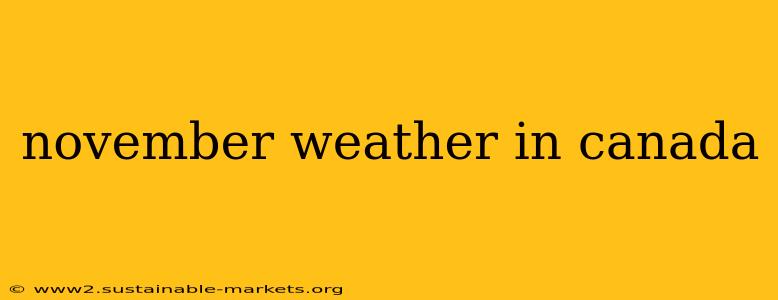November in Canada signals the official start of winter in many regions, bringing with it a dramatic shift in weather patterns. While some areas might still experience relatively mild temperatures, others brace for significant snowfall and plummeting temperatures. Understanding the nuances of November's weather across the vast Canadian landscape is crucial for planning travel, outdoor activities, and preparing for the colder months ahead.
Regional Breakdown of November Weather in Canada
Canada's diverse geography means that November weather varies significantly from region to region. Let's explore some key areas:
Eastern Canada (Atlantic Provinces & Quebec):
- Temperatures: Expect average daily highs ranging from just above freezing (0°C or 32°F) in southern areas to well below freezing in northern regions. Nights will consistently dip below freezing, leading to frost and potential icy conditions.
- Precipitation: November often brings a mix of rain and snow, with the potential for significant snowfall, particularly in higher elevations and northern areas. Freezing rain is a common hazard, making travel challenging.
- Wind: Strong winds are common, especially along coastal areas. These winds can dramatically increase the windchill factor, making temperatures feel much colder.
Central Canada (Ontario):
- Temperatures: Southern Ontario generally experiences temperatures hovering around freezing during the day, while nights are frequently below freezing. Northern Ontario sees significantly colder temperatures, often well below freezing throughout the day.
- Precipitation: A mix of rain and snow is expected, with snowfall increasing in frequency and intensity as you move north. Lake-effect snow can cause significant snowfall in localized areas near the Great Lakes.
- Wind: Blustery conditions are possible, particularly along the shores of the Great Lakes.
Western Canada (Prairies & British Columbia):
- Temperatures: The prairies experience a significant drop in temperatures throughout November, with daily highs often below freezing and overnight lows considerably colder. British Columbia's weather varies significantly based on location; coastal regions might experience milder temperatures and rainfall, while inland areas face colder temperatures and snowfall.
- Precipitation: Snowfall becomes more common across the prairies, especially in the northern regions. British Columbia's coastal areas will see more rain, while the interior experiences snowfall.
- Wind: Strong winds are a common feature across the prairies, contributing to significant windchill.
Northern Canada (Yukon, Northwest Territories, Nunavut):
- Temperatures: November marks the full onset of winter in Northern Canada. Expect consistently frigid temperatures, well below freezing throughout the day and night.
- Precipitation: Snow is the dominant form of precipitation, with potentially heavy snowfall and blizzards.
- Wind: Strong winds and blowing snow are frequent occurrences, leading to dangerous travel conditions.
Preparing for November Weather in Canada
No matter where you are in Canada, November requires preparation:
- Check weather forecasts regularly: Conditions can change rapidly.
- Pack appropriate clothing: Layers are essential, including warm hats, gloves, scarves, and waterproof outerwear.
- Ensure your vehicle is winter-ready: This includes winter tires, antifreeze, and an emergency kit.
- Be aware of potential hazards: Icy roads, snow, and strong winds can impact travel significantly.
November in Canada offers a unique beauty, but it's crucial to respect the changing weather conditions and take necessary precautions to ensure safety and comfort. By understanding the regional variations and planning ahead, you can fully enjoy the autumn's transition into winter's embrace.

